Proper care of the cyclamen after purchase
Indoor cyclamen belongs to primroses. It owes its appearance to the Persian cyclamen, which spread throughout the world from the eastern and African continents.
Back in the century before last cyclamen interested in breeders from Holland. Depending on the variety, the height of the flower ranges from 15 to 31 cm. Its leaves are heart-shaped or rounded with smooth or torn edges. The leaf plate is decorated with intricate streaks, strokes or specks. The main value of the flower is the autumn-winter period of flowering, and it is not difficult to grow it.
Content:
- What is the indoor cyclamen
- How to transplant a flower after purchase
- Competent care of cyclamen
- Disease and pest control
What is the indoor cyclamen
Today cyclamens are especially popular in indoor floriculture. Their genus numbers over 25 species. Most often, the following varieties can be found in an apartment:
- Persian. It is a tuberous plant that grows up to 30 cm. Its rich green leaves, decorated with silver patterns, are attached to the shoots with brown-red petioles. The diameter of the leaves can reach 14 cm. In winter, Persian cyclamens produce tall stalks, on which white, pink, red, burgundy or purple flowers bloom, which are practically odorless. After flowering, fruits with small seeds remain.
- Purple or European. It is a herbaceous evergreen crop that grows up to 15 cm. The foliage is rounded with jagged edges up to five centimeters in diameter. The upper part of the green leaf plate is decorated with silvery stains, and the lower one is brown in color. This cyclamen blooms with small flowers with a delicate scent. The petals are folded down and painted in shades from white to red. Flowering begins in the summer season and lasts until late autumn. Purple cyclamen tubers are irregular in shape and completely covered with roots.
- Cyclamen Victoria. The flower is distinguished by its sophistication. Against the background of emerald foliage with a white edge and an intricate pattern, snow-white flowers with pink or crimson fringes bloom. Flowering continues from autumn to spring. The plant grows up to 30 cm and requires special care.
- Caucasian. The leaves of this variety are round-elongated or heart-shaped. The foliage color is dark green or brown with different patterns. Produces small pink flowers. Their color can have different degrees of saturation. The tubers are brown in color and root from the bottom.
- Neapolitan or ivy. It belongs to frost-resistant varieties and has serrated leaves with clear grooves. The foliage is shaped like ivy. Glossy emerald leaf plates are painted with silvery marble stains. The plant blooms in the autumn with pink flowers with bent petals. The roots grow from the top of the tubers and this should be taken into account when planting.
The roots of all cyclamens have healing powers and help to treat sinusitis and rheumatism. They are also used to neutralize poisons from snake and insect bites.Today cyclamen is widely used in pharmaceuticals for the manufacture of medicines with sedative, anti-inflammatory and antimicrobial properties.
How to transplant a flower after purchase
By purchasing cyclamen, you need to take a flower on which the minimum number of flowers has blossomed, and multiple buds are hidden under the foliage. You should also pay attention to the appearance of the culture, because there are a number of signs that speak about the health of the culture:
- peduncles should be in an upright position
- leaves with good elasticity and should not have suspicious spots
- shoots must be clean, free of plaque and putrefactive formations
- the soil mixture should not be dry
- tubers peek out of the ground, except for the European cyclamen, the tubers of which must be completely immersed in the ground
If the flower is purchased in winter, then it must be well covered during transportation. If only tubers are bought, then you need to make sure that they are heavy and smooth, with the presence of growth buds. Repotting cyclamens is necessary if the plant is planted in transport peat. The flower is carefully removed from the pot and the tubers and roots are cleaned from the peat mixture, and then immersed in warm water for half an hour.
If there are traces of fungal diseases on the tubers, then they should be treated with a manganese solution or "Kornevin".
Before planting, old leaves are partially removed, leaving only young rosettes located in the central part. Watering after the procedure should be carried out no earlier than two days later and with a small amount of water. After transplanting, the cyclamen should be kept in a cool place. It is possible that after the procedure, the foliage of the plant will begin to turn yellow. Cut off the yellowed leaves. When the stress passes and the flower regains its strength, new greens and buds will begin to appear.
The next transplants will need to be carried out to change the soil, treat diseases or increase the pot. Experienced gardeners give some tips for transplanting cyclamen:
- The procedure should be carried out in the summer when the plant comes out of dormancy.
- The flower must be transplanted into a new container if new leaves appear on the tubers.
- Blooming cyclamen should not be transplanted, only if the flower needs urgent treatment.
- The pot must be selected small so that there is no more than three centimeters from the roots to the wall of the container.
- The overgrown plant is transplanted together with an earthen clod.
Also, when transplanting, the cyclamen variety should be taken into account. If the roots are formed at the bottom of the tubers, then they are not completely deepened into the soil. And if the roots are formed at the bottom or throughout the tuber, then it is buried completely.
The soil mixture for cyclamens is prepared by mixing leafy soil, humus and sand, in a 2: 1: 1 ratio. Humus can be substituted for perlite or peat. The acid-base pH reaction should be greater than seven. Higher levels increase the likelihood of disease. It is recommended to pre-disinfect the planting soil by heating it in a microwave oven or by treating it with a manganese solution. The bottom is equipped with drainage from granite, gravel or pebbles.
Competent care of cyclamen
To facilitate the care of the cyclamen and minimize possible problems, you need to create favorable conditions for the plant to develop:
- Mode lighting and temperature. It is best to place the flower on windowsills in rooms on the east and west sides so that it is not exposed to direct sun. In the southern rooms, cyclamen is placed far from the windows, and in the northern rooms, the illumination will be insufficient. In the summer, the cyclamen needs to ensure the temperature is at the level of 21-26 degrees, and in the winter - up to 15. The secret of abundant flowering lies precisely in low temperatures.
- Spraying secrets. To ensure the optimal level of humidity, the flower should be sprayed using settled or rainwater.But the procedure must be stopped as soon as buds are formed on the plant. For this period, the flower pot should be placed on moistened pebbles or peat.
- Features of flowering. Indoor cyclamens are distinguished by longevity and can delight owners with flowering up to fifteen years. They bloom profusely and can bloom about 75-80 flowers per season. To prolong the flowering of the plant, the faded buds are carefully removed, and the cliffs are sprinkled with charcoal.
- Irrigation. Home cyclamen is watered in two ways: from bottom to top, pouring water into the pan, or water is introduced along the edge of the planting container so that the stream of water does not hit the tubers. the water should be cool, below room temperature by 4-5 degrees. After flowering, watering is limited. In summer, the cyclamen retires, the foliage turns yellow and falls off. At this time, irrigation procedures are minimized. It should be remembered that cyclamen responds extremely negatively to excess moisture. They tolerate short-term drought much better. If the earthen lump is dry, then the pot should be placed in water for 40-50 minutes. Then the pot is wiped off and the plant is returned to its place.
- Fertilization. Nutrients are the key to abundant flowering and successful plant development. Fertilize cyclamens from the moment the green mass grows until the buds are set. Complex mineral dressings are applied twice a month. Cyclamens respond positively to organic fertilizers, and nitrogen-containing ones should be limited, because the risk of root decay increases. If the leaves turn yellow, then this is a signal that the flower is deficient in iron, and its deficiency should be compensated.
Disease and pest control
Indoor cyclamen is rarely exposed to diseases, but they can develop if the rules of agricultural technology are not followed. Diseases can be divided into three types:
- bacterial
- fungal
- nonparasitic
The first and second lead to the development of rot. They are provoked by many factors:
- wrong soil composition, with increased acidity
- large pot sizes
- wrong location of the flower
- violation of the irrigation regime
- incorrectly calculated fertilizer rates
- increased air temperature
Of the pests, cyclamen can affect:
- cyclamen mites
- shield aphids
- thrips
- elephant beetles
If harmful insects are found, it is necessary to carry out a comprehensive preventive treatment of the entire plant. For this, use fungicidal and acaricidal drugs. All damaged parts of the plant must be removed before processing. The soil in the pot must be completely changed, and the pot itself must be sterilized.
Also, cyclamen can affect leaf diseases. Most often, the flower is susceptible to: Fusarium wilt - a disease caused by a fungus. The foliage begins to turn yellow and fall off.
Low temperatures and high humidity, as well as a large amount of fertilizers, can provoke the development of the disease.
If you always pay close attention to the green friend and respond in time to the slightest changes in his condition and appearance, as well as strictly follow all the rules of agricultural technology, then cyclamen will delight with flowering for many years and not cause any trouble. The variety of varieties allows you to fill the house with bright colors from autumn to spring.
More information can be found in the video:



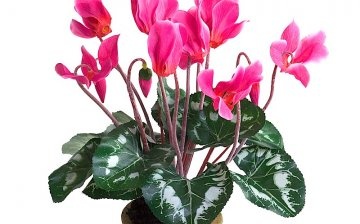


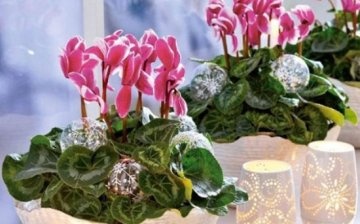
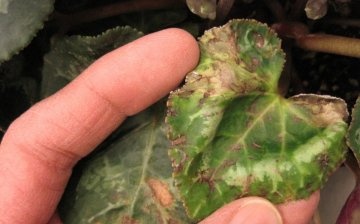






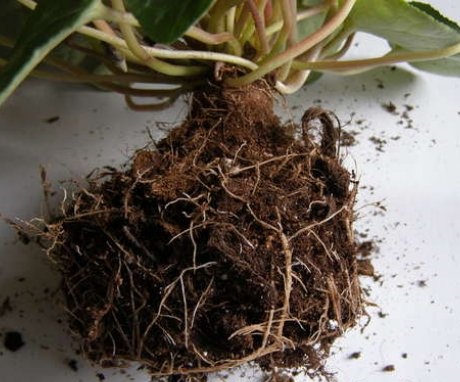
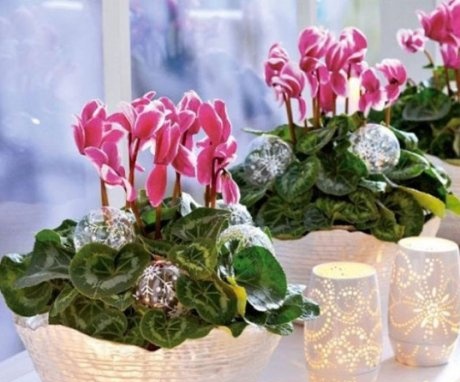
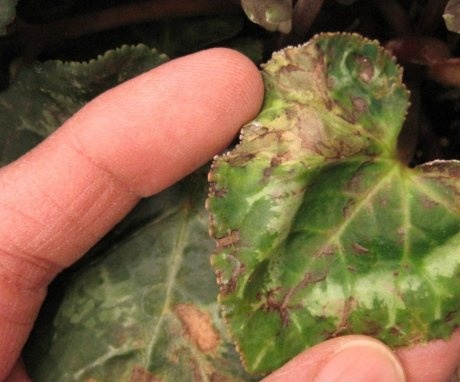
We had a cyclamen growing in a pot on the window. In 2014, when we urgently had to leave the city and there was no one to give the flower, we watered it well and left it for 2 months. When the flowers arrived, they dried up, but the cyclamen root survived.